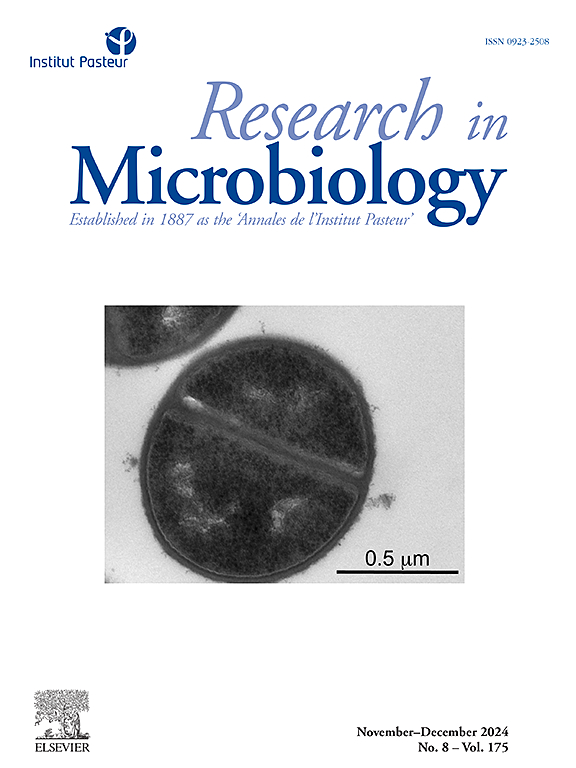Transcriptome analysis during thermal-induced endogenous mutagenesis in a strict psychrotrophic Aeromonas salmonicida subp. salmonicida strain
IF 3.4
4区 生物学
Q3 MICROBIOLOGY
引用次数: 0
Abstract
Aeromonas salmonicida is one of the earliest identified fish pathogens and the causative agent of furunculosis. A. salmonicida can be cultivated at temperatures as high as 30 °C, but at temperatures over 24 °C, insertion sequence (IS) elements cause endogenous mutagenesis. Here, we used a phenotypical and transcriptomics analysis to study the molecular aspects of A. salmonicida endogenous mutagenesis. Endogenous mutagenesis became evident after 12 h post-thermal induction and reached the highest level after 24 h. RNA was extracted from A. salmonicida grown at 15 and 28 °C after 16 h. Differential gene expression analysis showed that 344 differential expressed genes were up-regulated and 364 were down-regulated at 28 °C. Several ISs were upregulated in the chromosome and virulence plasmid. Virulence genes, including the type 3 secretion system, A-layer, and melanin synthesis, were downregulated. Overall, our result indicates that A. salmonicida incubated at 28 °C was under moderate heat stress but under strong stress caused by ISs mutagenesis. These results align with the hypothesis that ISs constrain virulent A. salmonicida to a psychrotrophic lifestyle, potentially transitioning to an attenuated mesophilic lifestyle.
严格嗜冷养型沙门氏气单胞菌亚群热诱导内源性突变的转录组。salmonicida压力。
沙门氏菌气单胞菌是最早发现的鱼类病原体之一,也是引起真菌病的病原体。沙门氏菌可在高达30°C的温度下培养,但在超过24°C的温度下,插入序列(IS)元件会引起内源性突变。在这里,我们使用表型和转录组学分析来研究沙门氏菌内源性诱变的分子方面。内源诱变作用在热诱导12 h后开始显现,24 h后达到最高水平。在15℃和28℃培养16 h后提取沙门氏菌RNA。差异基因表达分析显示,28℃条件下差异表达基因上调344个,下调364个。染色体和毒力质粒中多个ISs上调。毒力基因,包括3型分泌系统、a层和黑色素合成下调。总的来说,我们的结果表明,28°C孵育的沙门氏菌处于中等热应激状态,但处于ISs诱变引起的强应激状态。这些结果与假设一致,即ISs将毒性沙门氏菌限制为嗜冷性生活方式,可能过渡到减弱的嗜温性生活方式。
本文章由计算机程序翻译,如有差异,请以英文原文为准。
求助全文
约1分钟内获得全文
求助全文
来源期刊

Research in microbiology
生物-微生物学
CiteScore
4.10
自引率
3.80%
发文量
54
审稿时长
16 days
期刊介绍:
Research in Microbiology is the direct descendant of the original Pasteur periodical entitled Annales de l''Institut Pasteur, created in 1887 by Emile Duclaux under the patronage of Louis Pasteur. The Editorial Committee included Chamberland, Grancher, Nocard, Roux and Straus, and the first issue began with Louis Pasteur''s "Lettre sur la Rage" which clearly defines the spirit of the journal:"You have informed me, my dear Duclaux, that you intend to start a monthly collection of articles entitled "Annales de l''Institut Pasteur". You will be rendering a service that will be appreciated by the ever increasing number of young scientists who are attracted to microbiological studies. In your Annales, our laboratory research will of course occupy a central position, but the work from outside groups that you intend to publish will be a source of competitive stimulation for all of us."That first volume included 53 articles as well as critical reviews and book reviews. From that time on, the Annales appeared regularly every month, without interruption, even during the two world wars. Although the journal has undergone many changes over the past 100 years (in the title, the format, the language) reflecting the evolution in scientific publishing, it has consistently maintained the Pasteur tradition by publishing original reports on all aspects of microbiology.
 求助内容:
求助内容: 应助结果提醒方式:
应助结果提醒方式:


